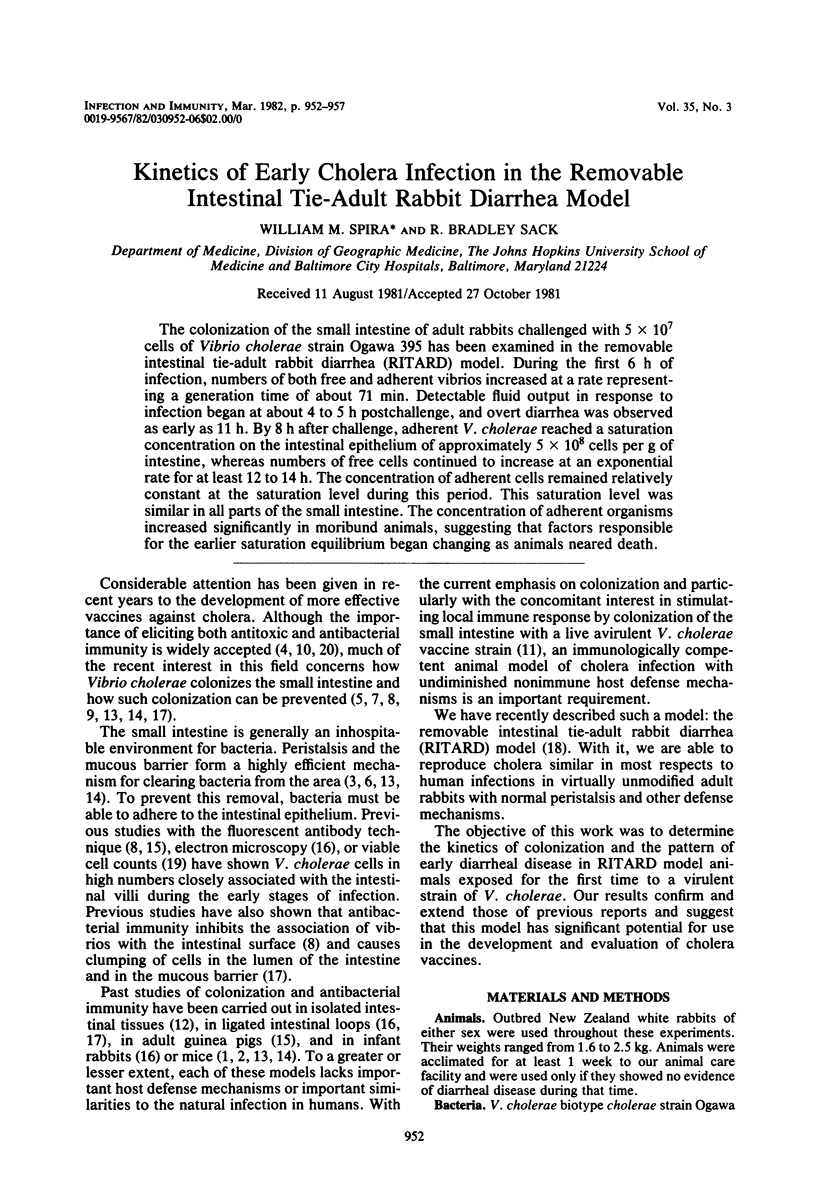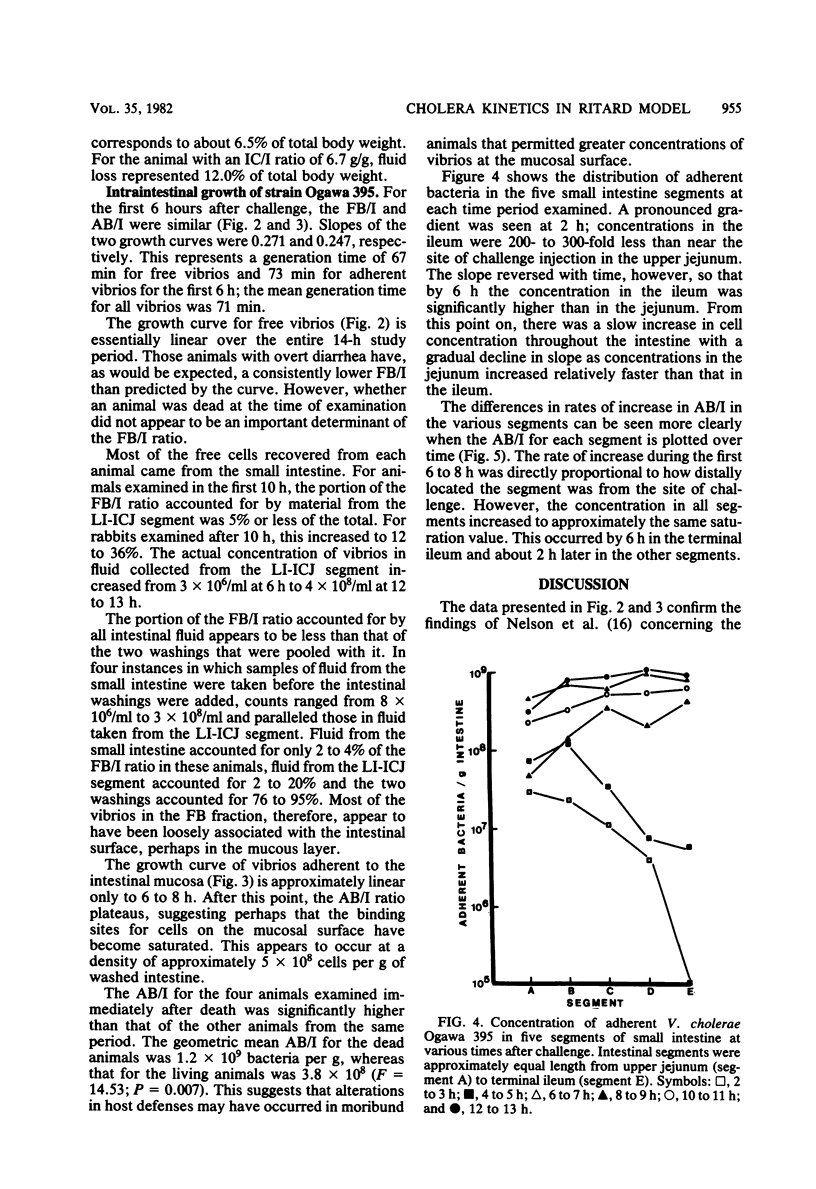Abstract
The colonization of the small intestine of adult rabbits challenged with 5 X 10(7) cells of Vibrio cholerae strain Ogawa 395 has been examined in the removable intestinal tie-adult rabbit diarrhea (RITARD) model. During the first 6 h of infection, numbers of both free and adherent vibrios increased at a rate representing a generation time of about 71 min. Detectable fluid output in response to infection began at about 4 to 5 h postchallenge, and overt diarrhea was observed as early as 11 h. By 8 h after challenge, adherent V. cholerae reached a saturation concentration on the intestinal epithelium of approximately 5 X 10(8) cells per g of intestine, whereas numbers of free cells continued to increase at an exponential rate for at least 12 to 14 h. The concentration of adherent cells remained relatively constant at the saturation level during this period. This saturation level was similar in all parts of the small intestine. The concentration of adherent organisms increased significantly in moribund animals, suggesting that factors responsible for the earlier saturation equilibrium began changing as animals neared death.
Full text
PDF





Selected References
These references are in PubMed. This may not be the complete list of references from this article.
- Baselski V. S., Medina R. A., Parker C. D. Survival and multiplication of Vibrio cholerae in the upper bowel of infant mice. Infect Immun. 1978 Nov;22(2):435–440. doi: 10.1128/iai.22.2.435-440.1978. [DOI] [PMC free article] [PubMed] [Google Scholar]
- Baselski V. S., Parker C. D. Intestinal distribution of Vibrio cholerae in orally infected infant mice: kinetics of recovery of radiolabel and viable cells. Infect Immun. 1978 Aug;21(2):518–525. doi: 10.1128/iai.21.2.518-525.1978. [DOI] [PMC free article] [PubMed] [Google Scholar]
- DIXON J. M. The fate of bacteria in the small intestine. J Pathol Bacteriol. 1960 Jan;79:131–140. doi: 10.1002/path.1700790116. [DOI] [PubMed] [Google Scholar]
- Freter R. Parameters affecting the association of vibrios with the intestinal surface in experimental cholera. Infect Immun. 1972 Aug;6(2):134–141. doi: 10.1128/iai.6.2.134-141.1972. [DOI] [PMC free article] [PubMed] [Google Scholar]
- Guentzel M. N., Berry L. J. Motility as a virulence factor for Vibrio cholerae. Infect Immun. 1975 May;11(5):890–897. doi: 10.1128/iai.11.5.890-897.1975. [DOI] [PMC free article] [PubMed] [Google Scholar]
- Holmgren J., Svennerholm A. M., Ouchterlony O. Experimental studies on cholera immunization. 1. The response of neutralizing and vibriocidal antibodies in rabbits after immunization with culture filtrate material from V. cholerae. Acta Pathol Microbiol Scand B Microbiol Immunol. 1972;80(4):489–496. [PubMed] [Google Scholar]
- Jones G. W., Abrams G. D., Freter R. Adhesive properties of Vibrio cholerae: adhesion to isolated rabbit brush border membranes and hemagglutinating activity. Infect Immun. 1976 Jul;14(1):232–239. doi: 10.1128/iai.14.1.232-239.1976. [DOI] [PMC free article] [PubMed] [Google Scholar]
- Knop J., Rowley D. Antibacterial mechanisms in the intestine. Elimination of V. cholerae from the gastrointestinal tract of adult mice. Aust J Exp Biol Med Sci. 1975 Apr;53(2):137–146. [PubMed] [Google Scholar]
- Knop J., Rowley D. Antibacterial mechanisms in the intestine. Elimination of V. cholerae from the intestines of infant mice and the role of antibody. Aust J Exp Biol Med Sci. 1975 Apr;53(2):147–154. [PubMed] [Google Scholar]
- Nelson E. T., Clements J. D., Finkelstein R. A. Vibrio cholerae adherence and colonization in experimental cholera: electron microscopic studies. Infect Immun. 1976 Aug;14(2):527–547. doi: 10.1128/iai.14.2.527-547.1976. [DOI] [PMC free article] [PubMed] [Google Scholar]
- Schrank G. D., Verwey W. F. Distribution of cholera organisms in experimental Vibrio cholerae infections: proposed mechanisms of pathogenesis and antibacterial immunity. Infect Immun. 1976 Jan;13(1):195–203. doi: 10.1128/iai.13.1.195-203.1976. [DOI] [PMC free article] [PubMed] [Google Scholar]
- Spira W. M., Sack R. B., Froehlich J. L. Simple adult rabbit model for Vibrio cholerae and enterotoxigenic Escherichia coli diarrhea. Infect Immun. 1981 May;32(2):739–747. doi: 10.1128/iai.32.2.739-747.1981. [DOI] [PMC free article] [PubMed] [Google Scholar]
- Srivastava R., Sinha V. B., Srivastava B. S. Events in the pathogenesis of experimental cholera: role of bacterial adherence and multiplication. J Med Microbiol. 1980 Feb;13(1):1–9. doi: 10.1099/00222615-13-1-1. [DOI] [PubMed] [Google Scholar]
- Svennerholm A. M., Holmgren J. Synergistic protective effect in rabbits of immunization with Vibrio cholerae lipopolysaccharide and toxin/toxoid. Infect Immun. 1976 Mar;13(3):735–740. doi: 10.1128/iai.13.3.735-740.1976. [DOI] [PMC free article] [PubMed] [Google Scholar]


